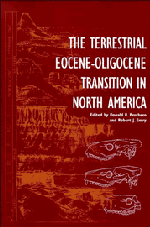Book contents
- Frontmatter
- Contents
- Contributors
- Preface
- PART I The Chronostratigraphy of the Uintan through Arikareean
- PART II Common Vertebrates of the White River Chronofauna
- 16 Testudines
- 17 Squamata
- 18 Ischyromyidae
- 19 Cylindrodontidae
- 20 Castoridae
- 21 Canidae
- 22 Nimravidae
- 23 Amphicyonidae
- 24 Small Arctoid and Feliform Camivorans
- 25 Merycoidodontinae and Miniochoerinae
- 26 Leptaucheniinae
- 27 Leptomerycidae
- 28 Camelidae
- 29 Hyracodontidae
- Summary
- Index
28 - Camelidae
Published online by Cambridge University Press: 06 July 2010
- Frontmatter
- Contents
- Contributors
- Preface
- PART I The Chronostratigraphy of the Uintan through Arikareean
- PART II Common Vertebrates of the White River Chronofauna
- 16 Testudines
- 17 Squamata
- 18 Ischyromyidae
- 19 Cylindrodontidae
- 20 Castoridae
- 21 Canidae
- 22 Nimravidae
- 23 Amphicyonidae
- 24 Small Arctoid and Feliform Camivorans
- 25 Merycoidodontinae and Miniochoerinae
- 26 Leptaucheniinae
- 27 Leptomerycidae
- 28 Camelidae
- 29 Hyracodontidae
- Summary
- Index
Summary
ABSTRACT
Our understanding of the early evolution of the Camelidae has long been confused by poor specimens, bad taxonomy, and dubious methodology, but the excellent specimens in the Frick Collection have clarified much of the confusion. The earliest known camelid is Poebrodon, from the early and late Uintan of Utah, Wyoming, and California. Hidrosotherium is not a camel at all, but a leptomerycid. Four valid species of Poebrotherium are recognized: P. chadronense, n. sp., and P. franki from the Chadronian of Texas; P. eximium from the Chadronian and early Orellan of the High Plains; and P. wilsoni, from the Chadronian to Whitneyan of the High Plains. “Poebrotherium” labiatum, from the early Orellan, is transferred to Paratylopus, which previously included only the type species, the Whitneyan camel Paratylopus primaevus. The long misunderstood camels known as “Protomeryx cedrensis,” “Protomeryx campester,” and “Paralabis matthewi” are now combined as Paralabis cedrensis.
The highly specialized, extremely hypsodont, gazellelike stenomyline camels of the late Arikareean-Barstovian have long been phylogenetically isolated, but Frick specimens show that Pseudolabis dakotensis (from the Whitneyan-Arikareean) and Miotylopus (from the Arikareean) are sister-taxa to the Stenomylini. Miotylopus includes three species: the small, Stenomylus-like M. leonardi; the medium-sized M. gibbi (including Dyseotylopus); and a large new species, M. taylori. Gentilicamelus sternbergi is the only valid species of this wastebasket genus, and is the sister-taxon of Nothokemas. The bizarre, long-snouted floridatragulines are closely related to higher camels.
- Type
- Chapter
- Information
- The Terrestrial Eocene-Oligocene Transition in North America , pp. 609 - 651Publisher: Cambridge University PressPrint publication year: 1996
- 2
- Cited by



